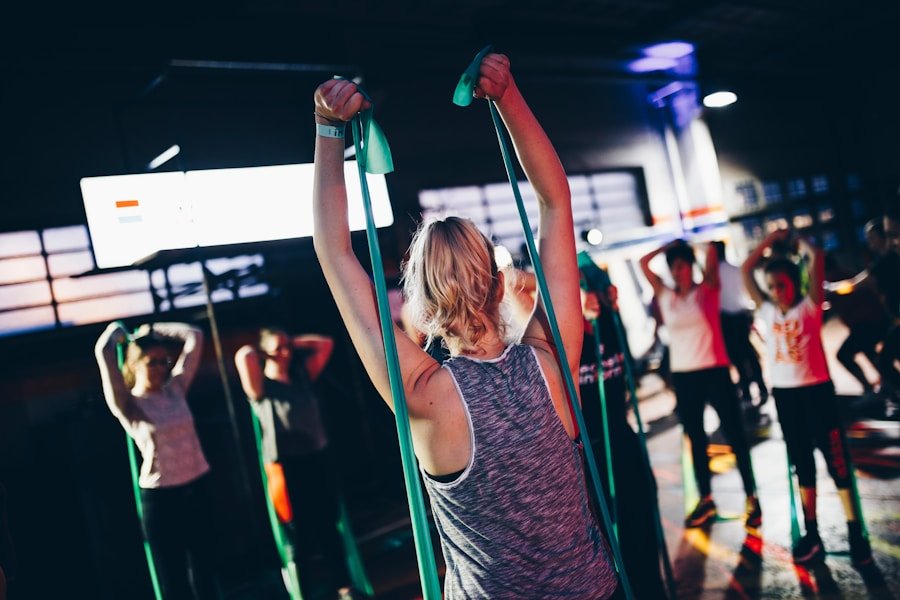Resistance bands have gained widespread popularity in the fitness industry due to their adaptability and efficacy in delivering a comprehensive full-body workout. Constructed from robust, elastic materials, these bands come in a range of resistance levels, making them accessible to individuals across the fitness spectrum. Regardless of whether you’re a novice seeking to build strength, an athlete striving to enhance performance, or someone recovering from an injury, resistance bands can be a valuable asset to your fitness regimen.
Unlike traditional weights, resistance bands provide continuous tension throughout the entire range of motion, thereby engaging muscles more effectively and improving overall strength and flexibility. In addition to their effectiveness, resistance bands are also characterized by their lightweight, portable, and affordable nature, rendering them a convenient option for those who prefer to exercise at home or while traveling. With the ability to target specific muscle groups and adjust resistance levels with ease, resistance bands offer a personalized workout experience that can be tailored to individual fitness objectives.
Whether your goal is to build muscle, improve flexibility, or increase endurance, resistance bands can be utilized in a variety of ways to achieve desired outcomes.
Key Takeaways
- Resistance bands are a versatile fitness tool suitable for all fitness levels
- They can be used for full-body workouts, strength training, muscle building, rehabilitation, injury prevention, and cardio/HIIT workouts
- Resistance bands are effective for building strength and muscle, as well as improving flexibility and range of motion
- When choosing resistance bands, consider your fitness level and the type of exercises you plan to do
- Incorporating resistance bands into your workout routine can add variety and challenge, helping you reach your fitness goals
How Resistance Bands Benefit All Fitness Levels
Accessibility for All Fitness Levels
One of the greatest benefits of resistance bands is their ability to accommodate individuals of all fitness levels. Whether you are a beginner, intermediate, or advanced exerciser, resistance bands can be used to provide a challenging and effective workout.
Benefits for Specific Fitness Levels
For beginners, resistance bands offer a gentle introduction to strength training, allowing them to build muscle and improve overall fitness without the risk of injury associated with heavy weights. Intermediate exercisers can use resistance bands to add variety and intensity to their workouts, while advanced individuals can use them to supplement their existing training routine and target specific muscle groups.
Low-Impact and Comprehensive Workout
Furthermore, resistance bands are particularly beneficial for individuals with joint pain or mobility issues, as they provide a low-impact way to strengthen muscles and improve flexibility. By using resistance bands, individuals can gradually increase the intensity of their workouts as they build strength and endurance, making them an ideal tool for rehabilitation and injury prevention. Additionally, resistance bands can be used to perform a wide range of exercises that target multiple muscle groups simultaneously, providing a comprehensive full-body workout for individuals of all fitness levels.
The Versatility of Resistance Bands for Full-Body Workouts
One of the key advantages of resistance bands is their versatility in providing a full-body workout. Unlike traditional weights, which often require separate equipment for different muscle groups, resistance bands can be used to target the arms, chest, back, legs, and core with just one piece of equipment. This makes them an ideal option for individuals who are short on time or space but still want to achieve a comprehensive workout.
With resistance bands, individuals can perform a wide range of exercises, including bicep curls, tricep extensions, chest presses, rows, squats, lunges, and abdominal crunches, among others. In addition to targeting specific muscle groups, resistance bands can also be used to improve overall stability and balance by engaging the core muscles during exercises. This not only helps to strengthen the core but also improves posture and reduces the risk of injury during other activities.
Furthermore, resistance bands can be easily adjusted to increase or decrease the level of resistance, allowing individuals to progress in their workouts and continue challenging their muscles as they become stronger. Whether you are looking to build muscle, improve flexibility, or increase endurance, resistance bands offer a versatile and effective way to achieve your fitness goals.
Resistance Bands for Strength Training and Muscle Building
| Benefits of Resistance Bands |
|---|
| 1. Versatility |
| 2. Suitable for all fitness levels |
| 3. Portable and lightweight |
| 4. Cost-effective |
| 5. Can be used for various exercises |
Resistance bands are an excellent tool for strength training and muscle building due to their ability to provide constant tension throughout the entire range of motion. This constant tension helps to engage muscles more effectively and stimulate muscle growth, making resistance bands an effective alternative to traditional weights. In fact, studies have shown that resistance bands can produce similar gains in muscle strength and size as free weights when used properly.
By using resistance bands for exercises such as bicep curls, tricep extensions, chest presses, rows, and squats, individuals can effectively target specific muscle groups and achieve significant gains in strength and muscle mass. Furthermore, resistance bands offer a unique advantage over traditional weights in that they allow for variable resistance throughout each exercise. This means that the resistance increases as the band is stretched, providing a greater challenge at the point of peak contraction when muscles are working the hardest.
This variable resistance helps to recruit more muscle fibers and stimulate greater muscle growth compared to traditional weights. Additionally, resistance bands can be used in combination with free weights or machines to add variety and intensity to strength training workouts. Whether you are looking to build muscle mass or increase strength, resistance bands offer a versatile and effective tool for achieving your fitness goals.
Using Resistance Bands for Rehabilitation and Injury Prevention
In addition to their effectiveness for strength training and muscle building, resistance bands are also valuable for rehabilitation and injury prevention. Due to their low-impact nature and ability to provide variable resistance, resistance bands are an ideal option for individuals recovering from injuries or dealing with joint pain. By using resistance bands, individuals can gradually strengthen muscles and improve flexibility without putting excessive strain on injured or sensitive areas.
This makes them an excellent tool for rehabilitating injuries and preventing future injuries by improving overall strength and stability. Furthermore, resistance bands can be used to perform specific exercises that target weak or underused muscles, helping to restore balance and function to the body. This is particularly beneficial for individuals recovering from injuries or dealing with imbalances caused by repetitive movements or poor posture.
By using resistance bands in a controlled manner, individuals can gradually increase the intensity of their workouts as they build strength and stability, reducing the risk of re-injury in the future. Whether you are recovering from an injury or looking to prevent future injuries, resistance bands offer a safe and effective way to rehabilitate the body and improve overall function.
Incorporating Resistance Bands into Cardio and HIIT Workouts
Enhancing Cardio Exercises
Incorporating resistance bands into cardio exercises such as jumping jacks, mountain climbers, or burpees can increase the intensity of workouts and engage additional muscle groups simultaneously. This not only improves cardiovascular endurance but also strengthens muscles throughout the body, providing a comprehensive full-body workout.
High-Intensity Interval Training (HIIT) with Resistance Bands
Resistance bands can also be used to perform HIIT workouts that combine short bursts of intense exercise with periods of rest or lower-intensity activity. By using resistance bands during HIIT workouts, individuals can increase the challenge of each exercise and maximize calorie burn while building strength and endurance.
Versatility and Effectiveness
Whether you are performing traditional cardio exercises or HIIT, resistance bands offer a versatile and effective way to enhance your workouts and achieve your fitness goals. They provide an excellent option for individuals looking to add variety and intensity to their cardio workouts without the need for additional equipment or space.
Tips for Choosing the Right Resistance Bands for Your Fitness Level
When choosing resistance bands for your fitness routine, it is important to consider your individual fitness level and goals in order to select the right bands for your needs. Resistance bands come in a variety of shapes, sizes, and resistance levels, so it is important to choose bands that are appropriate for your current strength and ability. For beginners or individuals recovering from injuries, it is best to start with lighter resistance bands that allow for gradual progression as strength improves.
These bands are typically color-coded based on their level of resistance, with lighter bands being designated by lighter colors such as yellow or green. For intermediate or advanced exercisers looking to build strength or increase intensity in their workouts, it is important to choose resistance bands with higher levels of tension that provide a greater challenge. These bands are typically designated by darker colors such as blue or black and offer more resistance than lighter bands.
Additionally, it is important to consider the length of the resistance bands when making your selection. Longer bands provide more versatility for exercises that require greater range of motion or attachment to stationary objects such as door frames or poles. In conclusion, resistance bands offer a versatile and effective way to achieve a full-body workout that is suitable for individuals of all fitness levels.
Whether you are looking to build strength, improve flexibility, rehabilitate an injury, or enhance your cardio workouts, resistance bands can be used in a variety of ways to achieve your fitness goals. By incorporating resistance bands into your fitness routine and choosing the right bands for your individual needs, you can experience the many benefits that these versatile tools have to offer. With their affordability, portability, and ability to provide constant tension throughout each exercise, resistance bands are an excellent option for anyone looking to improve their overall fitness and well-being.
FAQs
What are resistance bands?
Resistance bands are elastic bands used for strength training and physical therapy. They come in a variety of sizes, lengths, and resistance levels to accommodate different fitness levels and exercise routines.
What are the benefits of using resistance bands?
Resistance bands offer a wide range of benefits, including improving muscle strength, flexibility, and mobility. They are also lightweight, portable, and versatile, making them suitable for all fitness levels and easy to incorporate into various workouts.
How do resistance bands work for different fitness levels?
Resistance bands work for different fitness levels by providing varying levels of resistance. They can be used to make exercises easier or more challenging, depending on the individual’s strength and fitness level. This makes them suitable for beginners, intermediate, and advanced exercisers.
What exercises can be done with resistance bands?
Resistance bands can be used for a wide variety of exercises, including squats, bicep curls, shoulder presses, and leg lifts. They can also be incorporated into yoga, Pilates, and physical therapy routines to add resistance and challenge to the movements.
Are resistance bands suitable for all ages and fitness levels?
Yes, resistance bands are suitable for people of all ages and fitness levels. They can be used by beginners who are just starting their fitness journey, as well as by experienced athletes looking to add variety and challenge to their workouts. Additionally, resistance bands are often used in physical therapy for rehabilitation and injury prevention.














